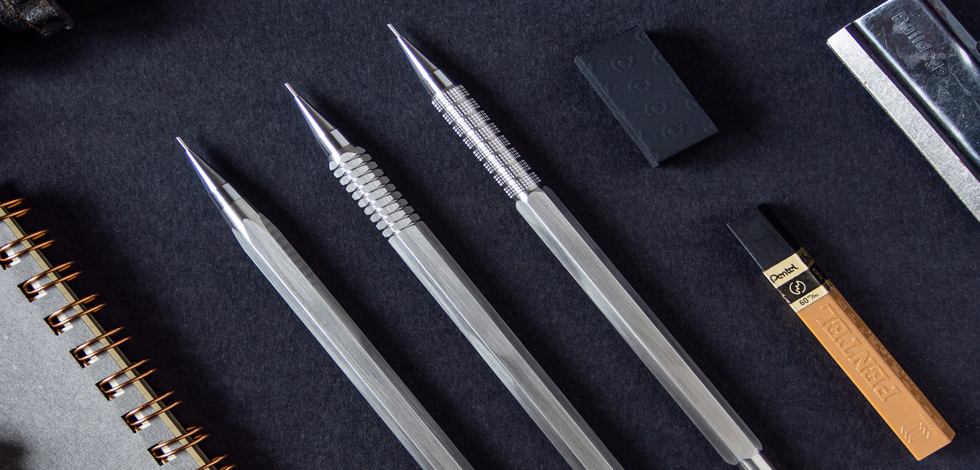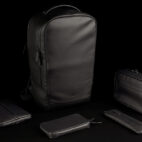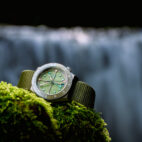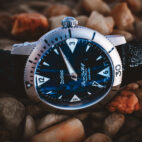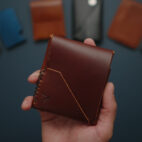The Best Mechanical Pencils to EDC in 2021
Shading gradients, very fine lines, consistent and reliable operation, and knowing a mistake is one eraser rescue away… the mechanical pencil was invented in the late 1800s but the modern version really took shape and was popularized in 1915 in Japan. Since then, they’ve been on draftsmen’s tables and mechanical engineers’ pockets and in the pencil case of every student that prefers writing with a piece of graphite instead of a nib filled with ink.
The lowly lead holder pencil has advanced significantly since WWI but the concept is mostly unchanged. Sub-millimeter lead is held in a tube and advanced using a clutch, through a lead pipe, when the user presses the knocker. However, that is not to say that improvements haven’t been made. Companies have produced pencils with mechanical solutions to breaking and uneven wearing lead. Others have sought to create mechanical pencils meant to be passed down to the next generation.
Choosing The Right Pencil For You
Like any tool, a mechanical pencil is an extension of you; your hands and your thoughts. It allows you to put thoughts to paper so it’s a very personal decision because what might work for someone else might not work for you. Consider the size, material, and any special features you may want.
Size | It’s All About Comfort
The obvious measurements that matter in a mechanical pencil are length and weight. Most pencils are around the 140mm mark or about 5.5 inches. This seems to be a sweet spot for most folks and I find that having a pen or pencil that is too short is much more of a detriment than one that is too long, unless it’s heavy and not balanced.
If you want a really compact pencil, something that can “post” (this means when you take the cap off of the writing end and store it on the back end), like the Sharp Kerry for example, would be ideal. It gives you the option of having a short instrument but you can also get that length by putting the cap on the eraser end.
Next, there’s weight. This can vary depending on the length, diameter, and material of the pencil. Most plastic mechanical pencils, even with metal components, weigh around 10 grams. But a full metal mechanical pencil like the Rotring 600 weighs over twice as much. Then, of course, there are metals like copper, which again weigh more. So if you love to maneuver your pencil with light, fast strokes, lighter is likely better for you.
Grip | Where You Hold It Matters
For all its five and a half inches, the main interface you have with a mechanical pencil is of course where you hold, or grip, it. Not surprisingly, this is the area that gets much of the focus, and where we see a lot of variation in pencil designs. There are endless variations in ways companies shape their grip section. Usually there is some sort of texturing or material difference (i.e. rubber) to aid in retention. All metal bodies often have knurling, or grooves cut into the metal. The path leading from the lead pipe up to the start of the grip can be stepped or tapered and variations in between.
Perhaps the most important dimension here, though, is where the grip section starts in relation to where the lead touches the paper. Every person holds mechanical pencils at a different height so if you tend to choke up on the pencil but your knuckles are not fully resting on the grip area, it’s going to make for an uncomfortable writing experience.
Materials | Steel is Real
If you are looking at stepping up your pencil game, there is no upgrade more obvious than trying mechanical pencils made out of metal. Metal doesn’t need to cost much either; the first recommendation on our list is just $3 USD and it actually weighs a little less than some of the more deluxe plastic pencils. As you step up, you will find makers like Number 9, Tactile Turn, and Modern Fuel that offer pencils in stainless, brass, copper, and even titanium.
For more “interesting” materials like brass and copper, there’s the added benefit of patina, developing with use. This is a thin layer that naturally forms on the surface over time and with use. This is accelerated with skin contact, which means it happens naturally with more use. One thing to note is a copper pencil could weigh almost five times as much as a polymer one. And at that point, the weight is noticeable!
A metal pencil is highly recommended because they are extremely durable and the nicer ones on our list will truly last a lifetime and can be passed on.
Special Features | No More Broken Lead!
Pencil manufacturers, particularly the Japanese, have come up with some really innovative and purely mechanical solutions to common lead pencil issues that have plagued students for years. The first is, of course, lead breakage. There are a few ways this has been addressed. The Orenz, for example, uses the lead pipe to completely cover the lead. It’s rounded on the edge so it doesn’t dig or get caught in the paper, despite being so thin. The DelGuard takes a two-pronged approach, through the clever use of springs and either extending the lead guard or allowing the lead to retreat when there is too much vertical or diagonal pressure.
The Kuru Toga has a system that allows the lead to constantly rotate as you write, making sure you have an even tip!
With all that said, if you’re ready to dive in, this is a curated list of the best mechanical pencils we recommend.
Zebra M-301 Stainless Steel
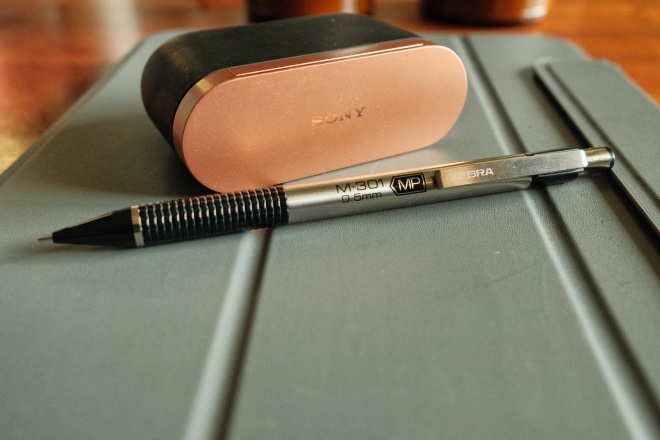
Starting off with the least expensive of the mechanical pencils on our list, it’s the Zebra M-301. It’s a stainless steel pencil that is really meant to be both accessible and ultra-durable. The non-slip grip means precise control while writing and it takes standard 0.5 mm lead. It measures 13.2 cm / 5.2 inches and weighs 9 grams. So it’s easy to carry around as part of your EDC or in your pocket.
Pentel Orenz 0.2mm
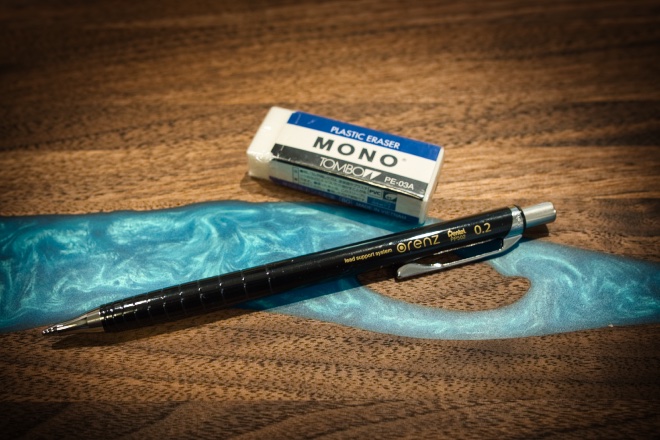
A mechanical pencil that features an astonishingly narrow 0.2 mm lead. This really seems specifically designed for students and engineers who need to write small notes, complex equations, or detailed graphs. Usually, thin leads mean breakage but the Orenz mechanism combats this. It features a guide pipe that completely envelopes the lead; you actually write with none of the lead extended. To advance the lead, you still click it on top, and the guide will extend with the lead inside. It’s made of plastic with a metal clip and measures 14.2 cm / 5.6 inches long and weighs just 10 grams. It also comes in over half a dozen color options, from standard black to sky blue and pink.
Zebra DelGuard Mechanical Pencil
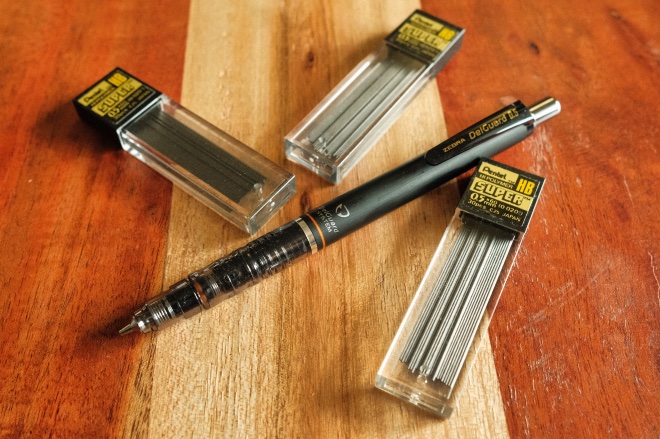
Many adults probably wish the Zebra DelGuard was around when they were students. A firm grip or brittle lead often results in breaks but Zebra has a two-pronged approach to protect against this. First, there is a spring in the barrel of the pencil that allows the lead to retract if there is too much vertical pressure. Second, a spring in the tip extends the lead guard to protect it against too much sideways (or angled) pressure. The DelGuard comes in two dozen options between the three lead sizes (0.3, 0.5, 0.7 mm) and different colorways. It measures 13.7 cm / 5.4 inches and weighs 10 grams; an impressive feat given the mechanisms included.
Pentel Graph Gear 1000
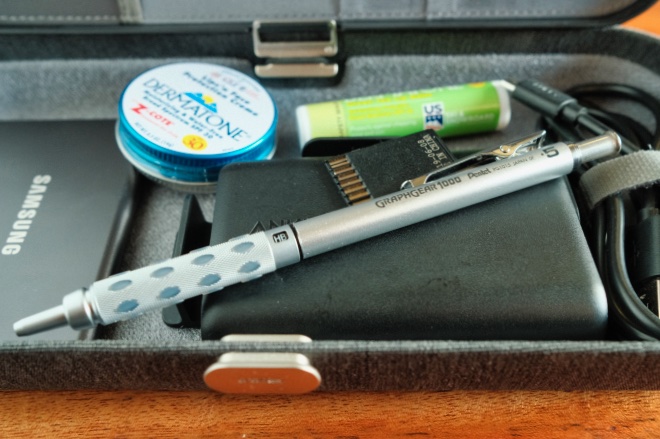
A bit of a specialty unit, the Graph Gear 1000 is a very popular drafting pencil. It’s a full aluminum body with a fully retractable tip that is incredibly balanced. The grip has very fine stippling and evenly spaced rubber textures to make it comfortable to hold and secure to grip. Lastly, it has a large metal spring clip that allows it to attach to thick objects like a notepad. It measures 14.9 cm / 5.9 inches and weighs 20 grams; so consider this extra weight and, especially, length when deciding if it fits in your workflow.
Uni Kuru Toga Roulette
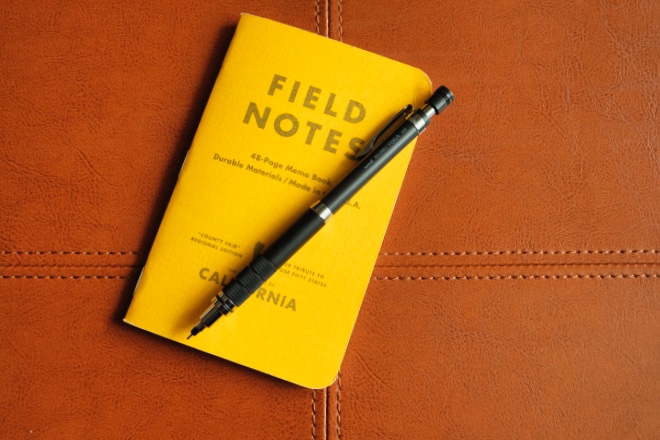
An ingenious solution to a problem that most people just accepted and took for granted, the Uni Kuru Toga Roulette has a rotation mechanism that continually rotates the pencil lead as you write. This ratcheting gear assures even wear of the lead. So there is no need to subconsciously spin the pencil body to prevent the dreaded wedge shape. This has the added benefit of producing uniform text, with no thin/thick or light/dark parts of the font. The Toga Roulette measures 14.6 cm / 5.7 inches and weighs 15 grams. This makes it slightly heavier than most plastic-bodied mechanical pencils but this is well worth it due to the roulette mechanism.
Pentel Sharp Kerry
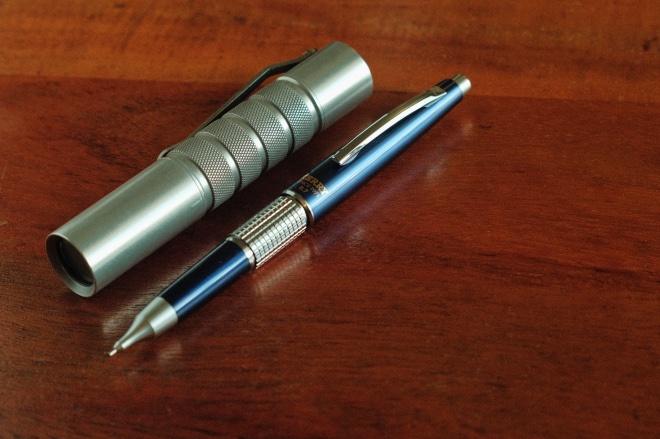
A truly gorgeous mechanical pencil that harkens back to the American executive rollerball pens that you might find on the desk of a company president. The Sharp Kerry has a distinct capped design that snaps on the back of the pencil with a satisfying and barely audible click. There is a refillable eraser hidden at the top of the cap and the lead is extended by clicking the button when the cap is unposted or on the top of the cap when it is. The body is made of a combination of metal and resin. It measures 13.2 cm / 5.2 inches posted and just 4.1 inches uncapped; both are in usable writable shape. It weighs 21 grams which is twice some of the lighter mechanical pencils on the list. But the balance is wonderful and is not heavy at all.
Rotring 600
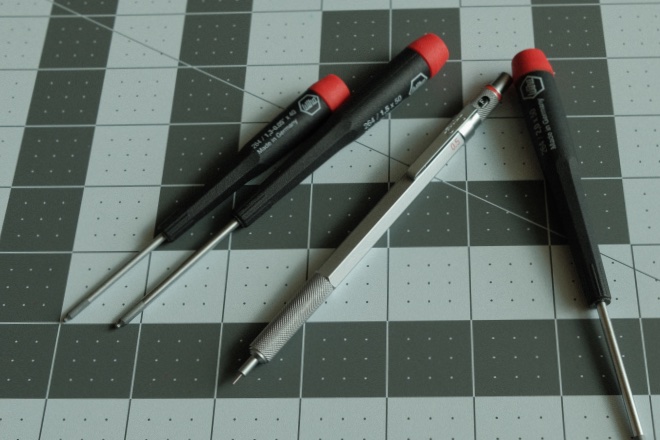
If there ever was an iconic mechanical pencil, the Rotring 600 would be it. To say it is a timeless design is an understatement. The 600’s strong industrial design means it fits right in its intended role as a drafting pencil. There is nothing organic here; the all-metal brass body, right angles, straight edges, and finely knurled grip is all business. It has a nice heft, thanks to the all-metal brass body but at 22 grams, you’d hardly call it heavy. The unique hexagonal body means no rolling off the drafting table; the metal clip aids in that as well.
The guide pipe gives a clear view of the lead. Speaking of lead, there’s even an indicator so you can quickly switch between your pencils with different graphite grades. The pencil has an 8mm grip which is a Goldilocks size and the body is slightly wider at 9mm. At the end of the 14.1 cm / 5.6-inch body you’ll find the iconic Rotring red ring. A recognizable design element any writer would spot from across the room.
Tactile Turn Pencil
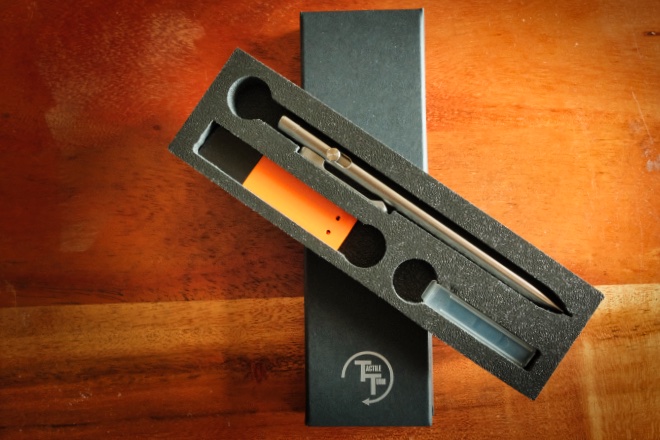
Tactile Turn has been machining custom pens, in Texas, since 2012. Almost ten years later, everything about their operation and products has evolved and improved. First introduced in 2018 and discontinued in 2020, to say the return of the Pencil is one of the most anticipated of 2021 is an understatement. The new version comes with a slimmer body (0.365″) and clip design while maintaining the bolt lead advance on the side and a replaceable friction eraser at the top. The Pencil uses a Schmidt DSM2006 mechanism. The engagement with the bolt is fiddly at first but becomes second nature after a few tries.
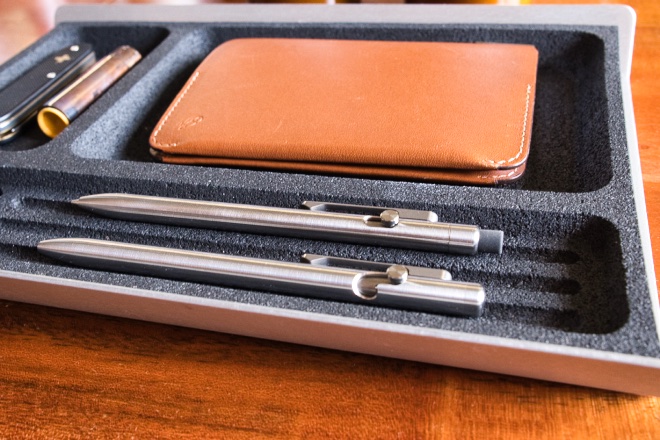
It’s available in four material finishes (titanium, copper, bronze, and zirconium) and two lead sizes (0.5mm and 0.7mm). And like most of Tactile Turn’s products, you can upgrade to a Damascus bolt or clip. The new packaging also snugly holds the pencil, three erasers, and a full set of leads in some precision cut high-density foam. The unboxing experiencing is very satisfying. Will and the team have managed to maintain the Tactile Turn DNA in the Pencil, with their iconic cut grooves, uniformly spaced end to end, while the added detail of the exposed rubber eraser immediately conjures memories of pencils from school days.
Number 9 Pencil
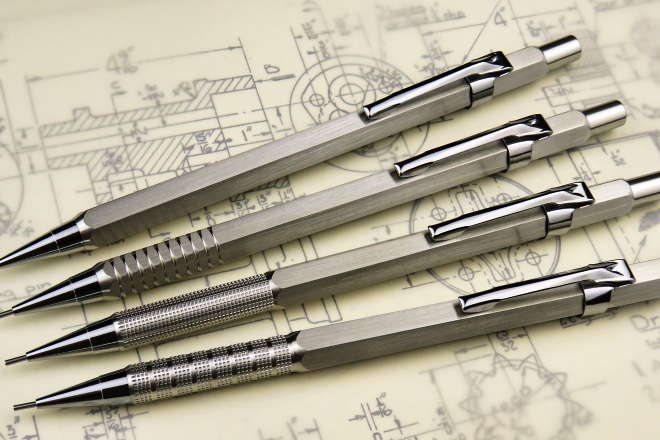
Launched on Kickstarter in 2019, the Number 9 is Dr. Lindsay Wilson’s attempt at taking an ordinary and often considered a disposable item and making it a premium piece that will last a lifetime.
An engineer and inventor at heart, Lindsay holds a Ph.D. in luminescent solar concentrators and by day sells a temperature controller (PID) he designed on his website. Like many scientists, it’s clear the Number 9 was an outlet to produce something physical and mechanical.
The Number 9 is based on the Sharp P207 drafting pencil from Pentel. Looking at the final product, there’s no denying the heritage. The Sharp has been in regular production since the 1970s and has been a fan favorite ever since. Its design and practicality are timeless so this was a great foundation.
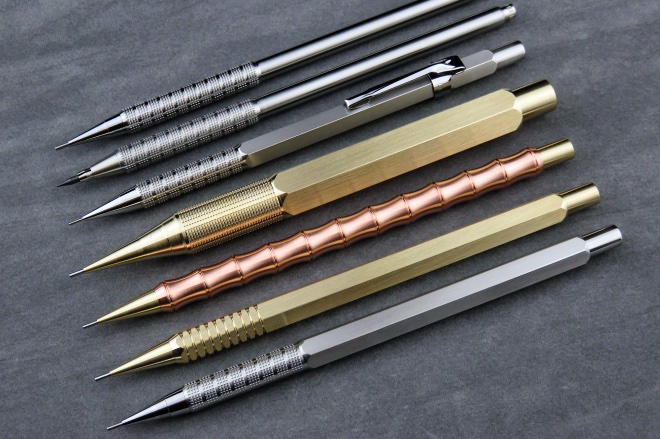
Everything about the production of the Number 9 Pencil is manually done, with meticulous attention to detail. Lindsay is most proud of his knurling, which produces the fine textured pattern in the grip area for a firm hold and fine control. Most knurling processes just stamp the pattern into the material using force, which can end up with distortions and damage the finish. Using a lathe, the grooves on the Number 9 are cut into the body of the pencil, ensuring a clean and consistent design.
There are six standard designs, separated into three pairs. Users can choose between a plain, grooved, or knurled grip with high and low taper or continuous or interrupted patterns for the latter. All bodies are 144mm long and measure 8mm across the hexagonal flats and 7.7mm across the grip. The pencil is offered in aluminum, brass, stainless steel, and titanium. And if all of the options described are still not sufficient, Lindsay has proven himself a capable machinist, producing custom versions with different sizes as well as patterns and designs (the bamboo is a popular choice).
Modern Fuel The Pencil 2.0
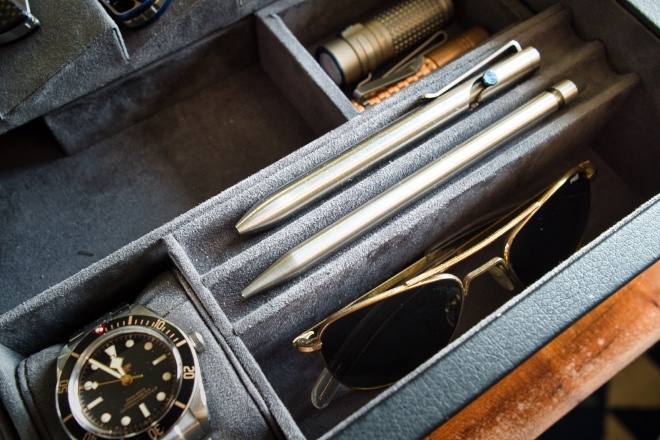
Originally launched on Kickstarter, The Pencil has gone through a few revisions and has now settled on v2. With a desire to create an heirloom piece, Andrew Sanderson’s take on the ubiquitous BIC Matic mechanical pencil is breathtaking. The pencil is carved out of a solid piece of metal and contains no plastic parts. Unlike some other custom mechanical pencils, the Modern Fuel version has an entirely custom, all-metal mechanism that powers it from within the machined body. The cone and body are machined separately but when mated together, leave no trace of a seam. It truly feels like a single piece of metal. The knock is solid metal and is internally threaded to hold the eraser plug. For maximum protection, the sleeve is retractable, protecting it from damage.
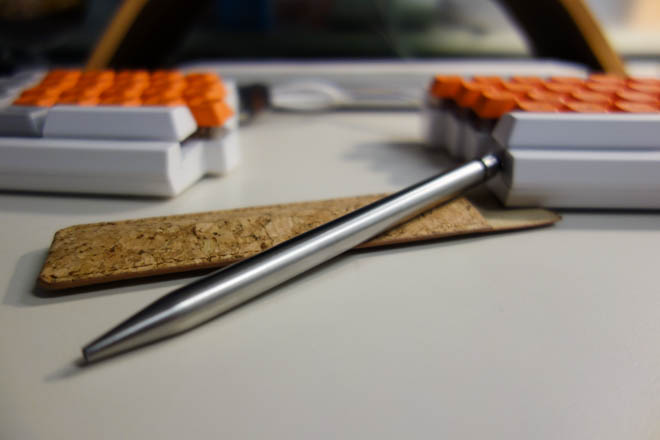
The Pencil is 145mm / 5.7 inches long and has a diameter of 9.5mm. It weighs 42g in the stainless option, with bronze and copper weighing a little more and the titanium offering a 35% reduction in weight. It comes standard with a 0.7mm mechanism. But 0.5 and 0.9mm options are available for purchase and video walkthroughs on the website guide the user through disassembly.
The pencil is a marvel to hold. Without the clip, it’s an uninterrupted line of brushed metal. The taper from the cone to the body is very subtle and levels off in a very soft way; not abrupt in the least. The finish doesn’t take a turn until you reach the eraser. But Modern Fuel has thought of everything – eraser plugs are available for that clean, all-metal look.





 Carry Awards
Carry Awards Insights
Insights Liking
Liking Projects
Projects Interviews
Interviews
